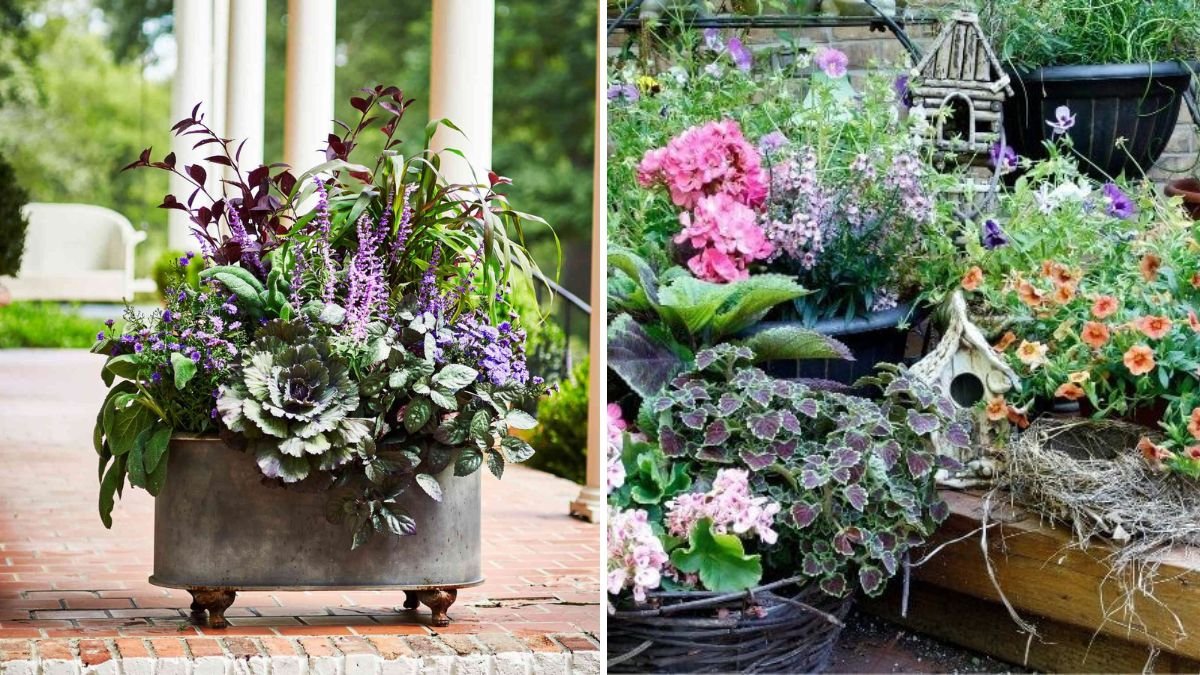Container gardening is a versatile and rewarding way to grow flowers, especially in spaces with limited sunlight, such as patios, balconies, and shaded corners of gardens. While many flowering plants thrive in full sun, shade-tolerant flowers can add color, texture, and charm to darker areas, turning them into vibrant, inviting spots.
This guide explores the best flowers for container displays in shade, including plant selection, container choices, soil preparation, watering, fertilization, and creative design ideas, helping gardeners create lush, low-light floral displays.
1. Understanding Shade and Its Implications
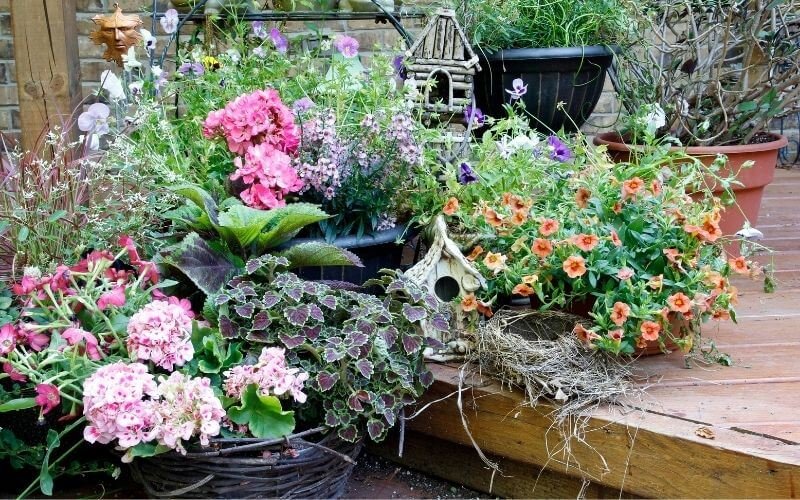
Shade is not uniform, and understanding the type of shade is crucial for successful container gardening:
- Full Shade: Less than 3 hours of direct sunlight daily; ideal for plants that prefer indirect light.
- Partial Shade (Filtered Light): 3–6 hours of sunlight, often morning sun or dappled light.
- Deep Shade: Areas blocked by walls, trees, or structures; only indirect light reaches these spots.
Tip: Observe your container location at different times of day to determine sunlight patterns and select suitable plants accordingly.
2. Advantages of Container Gardening in Shade
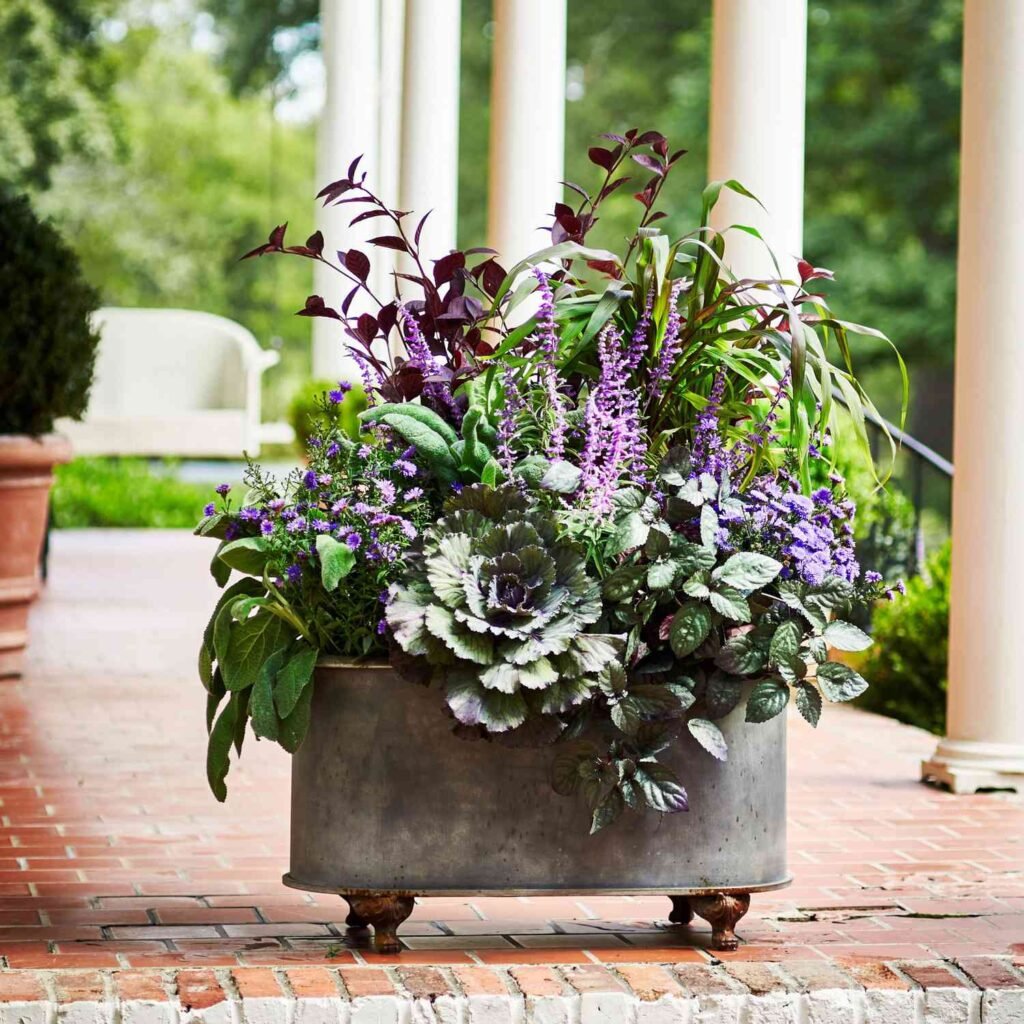
Shade container gardening offers several benefits:
- Space Efficiency: Ideal for small patios, balconies, or apartments.
- Mobility: Containers can be moved to optimize light or protect plants from harsh weather.
- Aesthetic Flexibility: Offers opportunities to mix foliage and flowering plants for a layered look.
- Reduced Heat Stress: Shade containers are less prone to drying out, reducing watering needs.
Tip: Shade gardens benefit from plants with colorful leaves and flowers to brighten darker spaces.
3. Choosing Containers for Shade Flowers
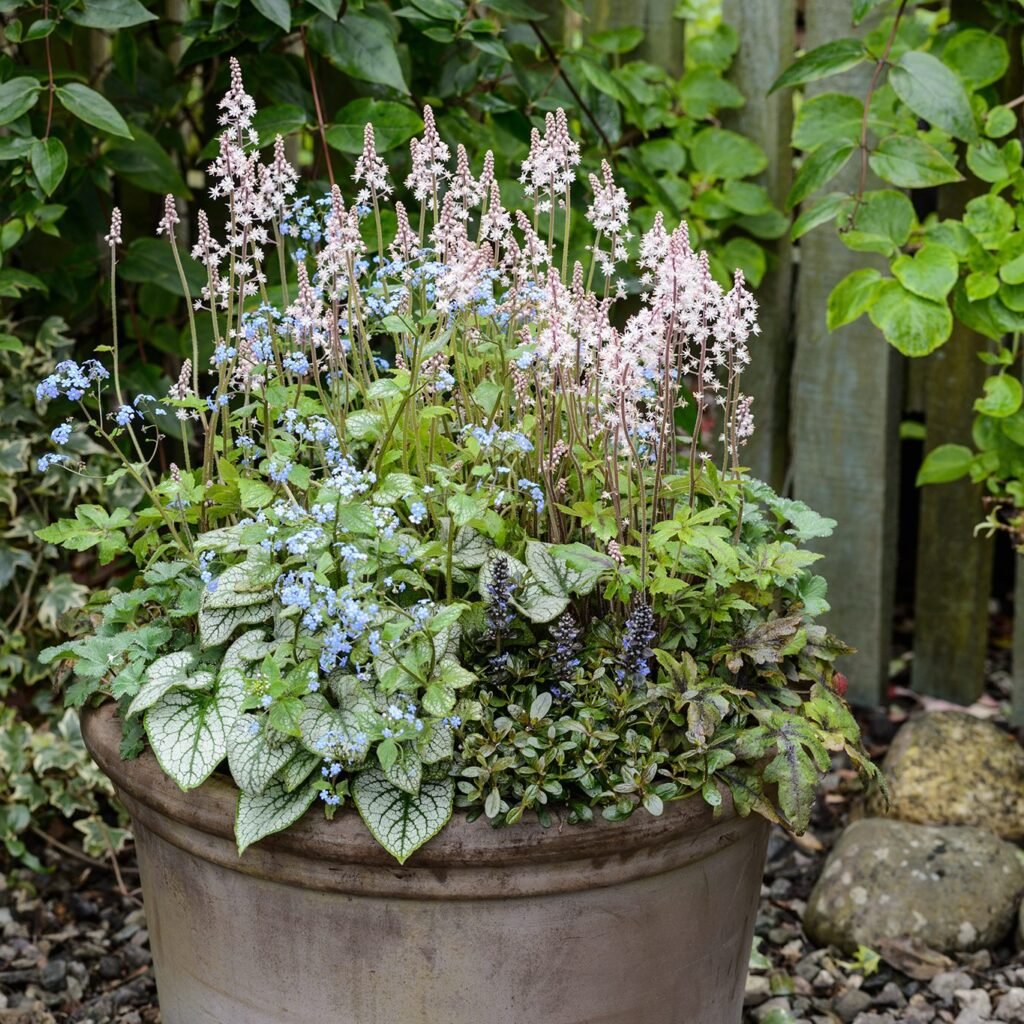
Container selection impacts plant health and appearance:
- Material: Terra-cotta retains moisture but may dry faster; plastic is lightweight and retains water; ceramic adds decorative appeal.
- Size: Larger containers allow more root growth and better moisture retention.
- Drainage: Drill holes in the bottom to prevent waterlogging.
- Mobility: Use pots with saucers or wheels for easy movement.
Tip: Darker foliage and colorful pots can enhance visual contrast in shaded areas.
4. Shade-Tolerant Flowers for Container Displays
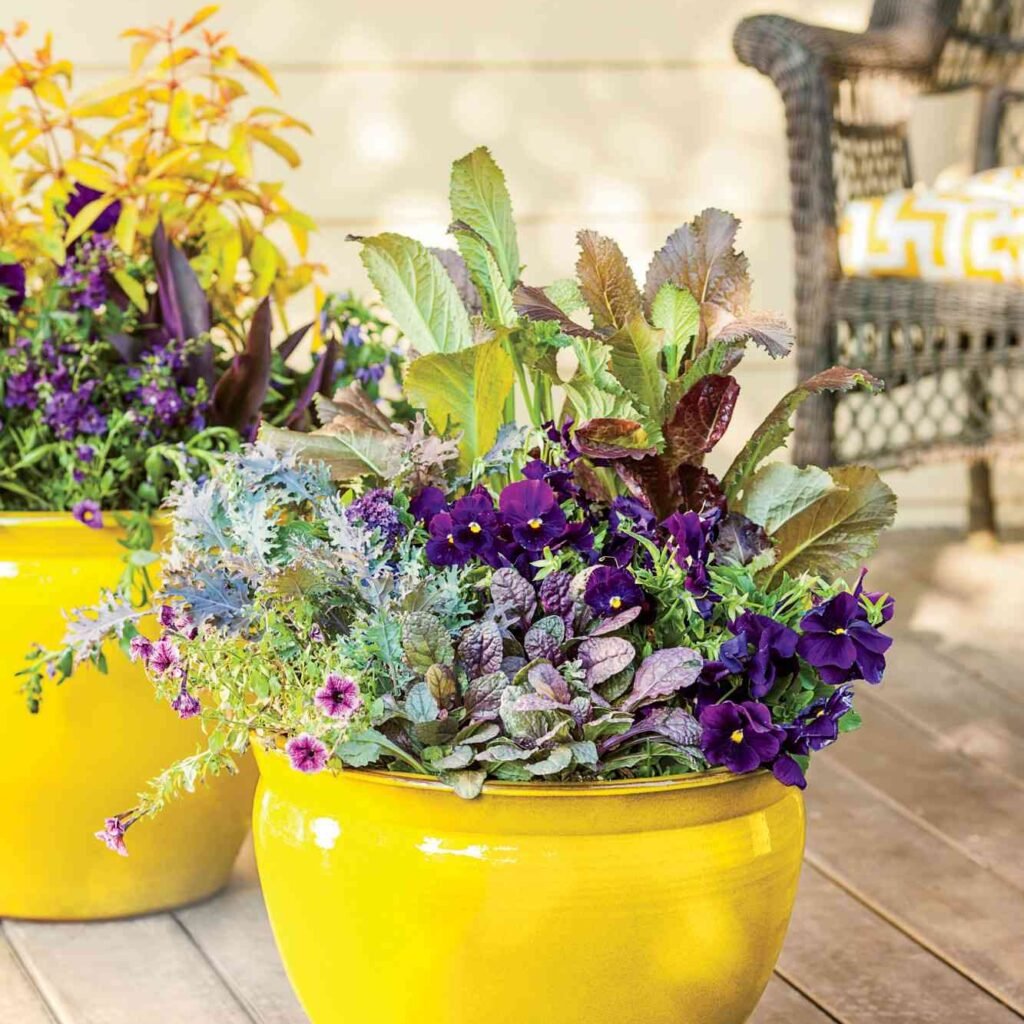
Several flowers thrive in shade while providing vivid colors and textures:
a) Impatiens
- Features: Bright, eye-catching flowers in red, pink, white, and purple.
- Benefits: Classic shade flower; continuous bloom throughout the season.
- Care: Needs consistent moisture and partial to full shade.
b) Begonias
- Features: Wax begonias offer glossy leaves and colorful blooms; tuberous begonias produce large, showy flowers.
- Benefits: Performs well in partial shade; ideal for containers or hanging baskets.
- Care: Water regularly; avoid overhead watering to prevent fungal diseases.
c) Hostas (Flowering Varieties)
- Features: Variegated or textured foliage; some produce fragrant blooms.
- Benefits: Excellent for deep shade; adds lush greenery and structure.
- Care: Prefers moist, well-drained soil; cut back spent flowers to maintain appearance.
d) Fuchsias
- Features: Pendulous, bell-shaped flowers in pinks, purples, and reds.
- Benefits: Adds elegance and attracts pollinators even in partial shade.
- Care: Requires regular watering and misting; partial shade is ideal.
e) Caladiums
- Features: Striking foliage with red, pink, green, and white patterns.
- Benefits: Provides visual interest without needing full sun; thrives in shaded containers.
- Care: Keep soil moist; avoid frost and extreme heat.
f) Lobelia
- Features: Small, vivid blue, purple, or white flowers forming trailing mats.
- Benefits: Perfect for container edges or hanging baskets; blooms profusely in shade.
- Care: Water consistently; partial shade enhances color intensity.
g) Astilbe
- Features: Feathery plumes in pink, red, or white; adds vertical interest.
- Benefits: Shade-tolerant and low maintenance; attracts butterflies.
- Care: Prefers consistently moist soil and partial shade.
h) Heuchera (Coral Bells)
- Features: Variegated foliage in shades of purple, green, and silver; delicate flower spikes.
- Benefits: Adds texture and color contrast in shaded containers.
- Care: Well-drained soil and partial shade; cut back flower stalks to maintain foliage focus.
5. Soil Preparation for Shade Containers
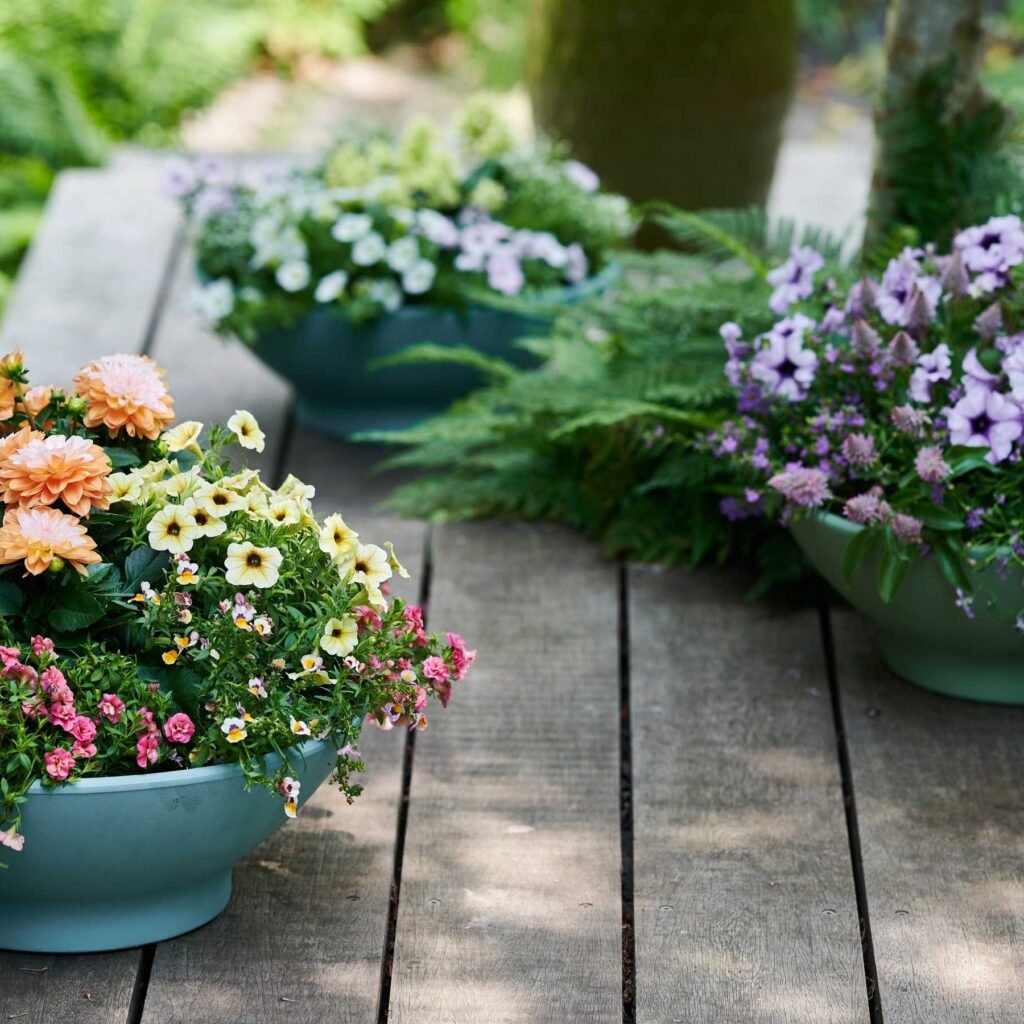
Shade plants often thrive in moist, nutrient-rich soil:
- Potting Mix: Use high-quality, well-draining potting soil.
- Organic Matter: Incorporate compost or leaf mold to enhance fertility and water retention.
- Drainage: Add perlite, sand, or small pebbles to prevent waterlogging.
- pH Level: Most shade flowers prefer slightly acidic to neutral soil (pH 6.0–7.0).
Tip: Avoid heavy garden soil alone, as it may compact and suffocate roots in containers.
6. Watering and Moisture Management
Shade containers often retain moisture longer, but proper watering is still crucial:
- Frequency: Check soil regularly; water when the top inch feels dry.
- Method: Water at the base to prevent fungal diseases on leaves and blooms.
- Mulching: Use organic mulch like bark chips or leaf litter to maintain soil moisture and reduce evaporation.
Tip: Container plants in deep shade may need less frequent watering than sun-exposed containers.
7. Fertilization for Shade Flowers
Container flowers depend on limited soil nutrients:
- Balanced Fertilizers: Use a slow-release fertilizer or liquid feed every 2–3 weeks.
- Organic Options: Compost tea or diluted fish emulsion improves soil fertility and encourages flowering.
- Leafy vs. Flowering: Adjust fertilizer based on plant growth—more phosphorus encourages blooms.
Tip: Avoid excessive nitrogen, which can promote leaf growth at the expense of flowers.
8. Plant Arrangement and Design
Thoughtful arrangement enhances visual appeal and plant health:
- Layering: Place taller plants like astilbe at the back and trailing plants like lobelia at the front.
- Grouping: Combine different textures and colors for contrast.
- Hanging Baskets: Use fuchsias, lobelia, or trailing begonias to add vertical interest.
- Mix Foliage and Flowers: Combine plants with colorful leaves (caladiums, hostas, heuchera) with flowers for a balanced container display.
Tip: Odd numbers of containers (3, 5, 7) create natural visual harmony.
9. Pest and Disease Management
Shade environments can be more humid, favoring certain pests and diseases:
- Common Issues: Aphids, slugs, spider mites, and fungal infections like powdery mildew.
- Prevention: Ensure good air circulation, remove dead leaves, and avoid overcrowding.
- Natural Control: Introduce beneficial insects, neem oil sprays, or organic insecticidal soap.
Tip: Inspect plants regularly, focusing on undersides of leaves where pests often hide.
10. Seasonal and Long-Term Care
Shade containers require adaptation to seasonal changes:
- Spring: Plant new container flowers; fertilize and water as growth resumes.
- Summer: Monitor for heat stress in partial shade; maintain moisture.
- Autumn: Trim spent blooms and remove dead foliage to prepare for winter.
- Winter: Protect frost-sensitive containers indoors or with covers; mulch to insulate roots.
Tip: Rotate containers periodically to maintain balanced growth and aesthetics.
11. Creative Tips for Shade Container Displays
- Color Contrast: Bright flowers like impatiens or begonias pop against dark green foliage.
- Trailing Plants: Use lobelia or ivy to soften container edges.
- Mixed Containers: Combine foliage and flowering plants for layered textures.
- Decorative Elements: Add stones, miniature statues, or colorful pots for visual interest.
- Mobility: Lightweight containers allow you to rearrange for seasonal changes or sunlight optimization.
Tip: Experiment with different plant combinations to create unique, personalized container displays.
Conclusion
Creating beautiful container displays in shade requires careful plant selection, proper soil preparation, and consistent care. By choosing shade-tolerant flowers, arranging containers thoughtfully, and maintaining healthy growing conditions, gardeners can transform even the darkest corners into lush, vibrant, and inviting spaces.
Key takeaways:
- Determine sunlight levels before selecting plants.
- Use well-draining, nutrient-rich potting soil.
- Choose shade-loving flowers like impatiens, begonias, hostas, and fuchsias.
- Water and fertilize appropriately for container growth.
- Incorporate layering, trailing plants, and color contrast for visual impact.
- Monitor and manage pests naturally.
- Adjust care seasonally to maintain health and blooms.
- Use creative container designs to enhance aesthetic appeal.
- Mix foliage and flowering plants for texture and depth.
- Rotate and maintain containers for continuous charm throughout the year.
With thoughtful planning and care, shade containers can become stunning focal points, offering color, fragrance, and natural beauty, even in low-light areas.
